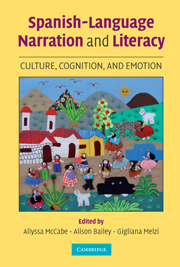Book contents
- Frontmatter
- Contents
- List of Contributors
- Preface
- Acknowledgments
- 1 Introduction
- PART ONE PARENT–CHILD NARRATIVES
- 2 Cultural Variations in Mother–Child Narrative Discourse Style
- 3 Early Sociocommunicative Narrative Patterns During Costa Rican Mother–Infant Interaction
- 4 Lessons in Mother–Child and Father–Child Personal Narratives in Latino Families
- 5 Evaluation in Spanish-Speaking Mother–Child Narratives: The Social and Sense-Making Function of Internal-State References
- 6 Love, Diminutives, and Gender Socialization in Andean Mother–Child Narrative Conversations
- PART TWO DEVELOPING INDEPENDENT NARRATION
- PART THREE NARRATIVE LINKS TO LITERACY AND OTHER SCHOOL ACHIEVEMENTS
- Author Index
- Subject Index
- References
5 - Evaluation in Spanish-Speaking Mother–Child Narratives: The Social and Sense-Making Function of Internal-State References
Published online by Cambridge University Press: 05 June 2012
- Frontmatter
- Contents
- List of Contributors
- Preface
- Acknowledgments
- 1 Introduction
- PART ONE PARENT–CHILD NARRATIVES
- 2 Cultural Variations in Mother–Child Narrative Discourse Style
- 3 Early Sociocommunicative Narrative Patterns During Costa Rican Mother–Infant Interaction
- 4 Lessons in Mother–Child and Father–Child Personal Narratives in Latino Families
- 5 Evaluation in Spanish-Speaking Mother–Child Narratives: The Social and Sense-Making Function of Internal-State References
- 6 Love, Diminutives, and Gender Socialization in Andean Mother–Child Narrative Conversations
- PART TWO DEVELOPING INDEPENDENT NARRATION
- PART THREE NARRATIVE LINKS TO LITERACY AND OTHER SCHOOL ACHIEVEMENTS
- Author Index
- Subject Index
- References
Summary
Key words: narrative, evaluation, internal states, mother–child conversations, theory-of-mind, social cognition, autobiographical memory, Spanish, Latino children.
ABSTRACT
Young children's sociocognitive skills, such as their understanding of others' feelings and their ability to explain human action in terms of beliefs, emotions, and intentions, has been associated with naturally occurring talk about internal states in everyday family interactions. The frequency with which children engage in conversations about internal states is related to various aspects of sociocognitive development, including emotion recognition, affective perspective-taking, and false-belief understanding. Various individual and contextual factors influence the language used between parents and children during daily family interactions. However, most studies to date have examined the use of internal-state language in English-speaking homes; thus, results might not be generalizable to other cultural groups. The current study addressed this gap in the literature by examining the manner in which Spanish-speaking Peruvian mothers discussed internal states with their preschooler in two narrative contexts: conversations about the personal past and storybook-sharing interactions. The conversations in these two contexts between 32 middle-class mothers and their preschool-aged children (i.e., ages 3 and 5) were analyzed for the frequency and patterns of use of internal-state references. Results show gender and age differences in the use of internal-state references only in the narrative-conversation context. The chapter concludes with a discussion of the theoretical and empirical links between children's narrative competence and their sociocognitive skills.
- Type
- Chapter
- Information
- Spanish-Language Narration and LiteracyCulture, Cognition, and Emotion, pp. 92 - 118Publisher: Cambridge University PressPrint publication year: 2008
References
- 6
- Cited by



